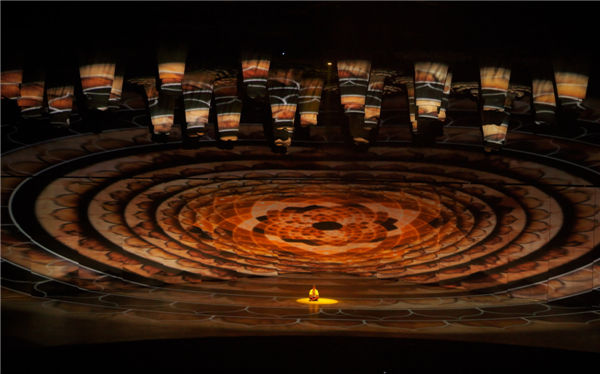Theater of life
Updated: 2014-10-27 07:42
By Chen Jie(China Daily)
|
|||||||||||
 |
|
Both the stage and auditorium can revolve. |
Located in North China's Shanxi province, Wutai is one of the four sacred Buddhist mountains in the country, seen as the global center for the worship of Manjusri (known as Wenshu in China), an avatar of the Buddha who represents transcendent wisdom. Once there were more than 120 temples; 47 now remain, including Foguang Temple of the Tang Dynasty (618-907) and Shuxiang Temple of Ming Dynasty (1368-1644). It was declared a UNESCO World Heritage Site in 2009.
Shanxi province is known for its coal industry. In order to promote its culture, the leaders commissioned Wang, who is among Chin's top directors of tourist shows, to create productions for the province.
Wang's previous productions were all staged in the open in southern China, but in the north, it's impractical to run open-air shows in late autumn and winter.
Her first production in Shanxi was Encore Pingyao. Pingyao was a financial center of China during the Qing Dynasty (1644-1911) and is now a well-preserved ancient town. The theater is composed of two parts: one like a film studio with ancient streets, shops, courtyards and performers; the other a stage and auditorium setting.
In a prologue to the show, the audience first walked through the "streets" and interacted with the performers, to experience what the area was like hundreds of years ago. Then they were guided into the auditorium to watch the ending of the story.
At Wutai Mountain, Wang continues that approach but the stage is bigger (131 by 75 by 21.5 meters), and both the stage and auditorium can revolve.
That's thanks to the collaboration between Wang and architect Zhu Xiaodi, head of Beijing Institute of Architectural Design.
Related Stories
Beijing International Biennale sparks discussion 2014-10-17 14:47
Fresh appeal to Peking Opera 2014-10-17 07:19
Last Chinese Emperor's life as citizen featured in new play 2014-09-15 08:42
Tap Dogs stomp into town 2014-09-12 07:00
Better cinema experience coming to Chinese homes 2014-09-11 07:56
Today's Top News
Russia signs discount on gas supplied to Ukraine
Police, youths clash at protests in French cities
China seeks pragmatic cooperation with Arctic countries
FAW-Volkswagen demanded to submit recall materials
Can private space survive two explosions in four days?
Chinese companies make strides in the UK
Trilateral talks on Ukraine gas reaches agreement: EU
Culture ministry: no politics, no propaganda, only China
Hot Topics
Lunar probe , China growth forecasts, Emission rules get tougher, China seen through 'colored lens', International board,
Editor's Picks

|

|

|

|

|

|







